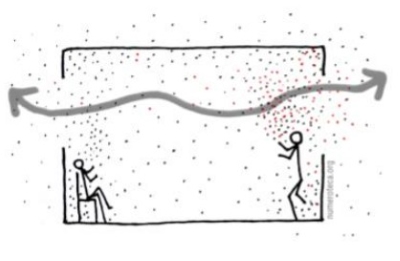COVID-19 - Masks & Ventilation
COVID-19 - Masks & Ventilation
COVID-19 is airborne and can spread easily from one person to another. Wearing masks and ventilating spaces are key ways to help reduce the spread of COVID-19 and other airborne illnesses.
Key points on masks and ventilation
- airborne illnesses such as COVID-19 and the flu spread through the air
- mask wearing helps limit the spread of COVID-19 and other airborne illnesses
- wearing masks remains important in healthcare settings
- opening doors and windows at home is the simplest way to improve ventilation
Why is wearing a mask important?
Wearing masks reduces the risk of spreading COVID-19 and other airborne illnesses.
Mask wearing remains important in healthcare settings. The New Zealand government still recommends people wear masks in the following places:
- hospitals and doctors' clinics, including after-hours clinics
- community and iwi healthcare providers
- hospices
- rest homes or care facilities for older people
- care facilities for people with disabilities and disability support services
- pharmacies
- ambulance services
- health services such as blood testing or radiology services
- dental clinics
- health services such as optometrists and physiotherapists
When visiting healthcare service providers, they may ask you to wear a mask.
It's important to wear a face mask when visiting people at high risk of becoming very unwell from COVID-19, or other illnesses affecting breathing. This includes older people, babies and people who have health conditions.
How does mask wearing reduce the chance of spreading infections?
NIWA Taihoro Nukurangi air quality scientists have made a short video using a special camera. This video shows what happens to our breath when we're indoors, with and without masks and with high and low airflow. It shows how mask wearing and ventilation reduce the chance of infecting others.
CO2 sensing camera picks up breath plumes (video from NIWA)
Read KidsHealth information on COVID-19 - what you need to know
Why is ventilation important?
Ventilating with fresh air can reduce the risk of spreading COVID-19. Opening doors and windows at home is the simplest way of improving ventilation and helps protect you and your whānau.
How does ventilation reduce the chance of spreading infections?
Below are some drawings showing how ventilation can help reduce the spread of airborne viruses like COVID-19.
The air people breathe out contains airborne viruses. When all windows and doors are closed, the viruses gather in the air and move around the room.

When the windows or doors are open, a cross-breeze helps push the air with viruses outside.

A heat pump does not improve ventilation. It moves the air around inside. It makes the air colder or warmer but does not improve the quality of the air. The risk of breathing in COVID-19 or other viruses does not change.

Use a HEPA filter to improve the quality of the air. These filters take in air and remove virus particles before returning the air to the environment.

How can I stop COVID-19 and other airborne illnesses from spreading?
Wear a mask
Mask wearing can prevent the spread of COVID-19 and other illnesses affecting breathing. It's especially important to consider wearing a mask in healthcare settings and around at-risk people.
Open windows and doors
Open windows and doors safely, whenever possible, especially during sleep times.
Open windows or doors on opposite sides of the room so the air can flow more easily. Having doors and windows open for as little as 15 minutes exchanges stale inside air for fresh outside air.
Keep windows open even in winter - opening several windows as little as 5cm creates an effective air flow, reducing the risk of infection.
HEPA filters
Heat pumps do not exchange inside air for fresh outside air. They don't remove the virus. If your heat pump is on, make sure you still open windows to improve ventilation.
You can buy HEPA filters to improve the quality of the air. These filter the virus and allergens out of the inside air, reducing the risk of infection.
How does COVID-19 spread?
COVID-19 spreads between people who are close to each other. It spreads most easily in closed spaces, crowded settings and where there is poor ventilation. The World Health Organisation developed this video to show how the virus spreads.
More KidsHealth content on COVID-19
Find out about caring for a child with COVID-19
See KidsHealth's section on COVID-19
See all KidsHealth's content on COVID-19 immunisation in children
This page last reviewed 27 November 2023.
Do you have any feedback for KidsHealth?
If you have any feedback about the KidsHealth website, or have a suggestion for new content, please get in touch with us.
Email us now